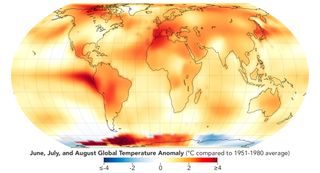News
Science & Astronomy

This map depicts global temperature anomalies for meteorological summer in 2023 (June, July, and August). It shows how much warmer or cooler different regions of Earth were compared to the baseline average from 1951 to 1980.
(Image credit: NASA Earth Observatory/Lauren Dauphin)
Scorching heat waves in North America, Europe, Asia and elsewhere have deemed this year’s summer as Earth’s hottest since at least 1880, NASA confirmed yesterday (Sept. 14), referring to when global record-keeping of temperatures began.
2023’s record-setting heat is a result of human-driven global warming and is compounded by a brewing, recurring climate pattern known as El Niño, according to the space agency.
A statement outlining the analysis says August alone was 2.2 degrees Fahrenheit (1.2 degrees Celsius) warmer than an average summer, blanketing a record 57 million people in the southern and southwest U.S. under a heat wave of the most severe category.
Temperatures in June, July and August combined were 0.41 degrees Fahrenheit (0.23 degrees Celsius) warmer than all previous summers, according to the latest report. In another NASA conference on the planet’s climate emergency last month, scientists confirmed July of this year to be the hottest on record, with the previous five hottest Julys all in the past five years.
“Just look around you and you’ll see what’s happened,” NASA administrator Bill Nelson said during the conference. “We have record flooding in Vermont. We have record heat in Phoenix and in Miami. We have major parts of the country that have been blanketed by wildfire smoke and, of course, what we are watching in real-time is the disaster that has occurred in Hawaii with wildfires.”
Related: Satellites reveal catastrophic year for emperor penguins amid climate crisis in Antarctica
July’s searing heat directly contributed to the deadliest wildfire season on record for both Canada and Hawaii, as well as to severe rainfall and flash floods across the Mediterranean including in Greece and Italy, scientists say.
They attribute this record heat in part to El Niño, which occurs about every two to seven years when winds above the Pacific ocean, which normally blow to the west along the equator from South America towards Asia, break their routine and drift east and toward the U.S. west coast. As a result, Canada and the U.S. witness much warmer conditions than usual.
“Exceptionally high sea surface temperatures, fueled in part by the return of El Niño, were largely responsible for the summer’s record warmth,” Josh Willis, who is a climate scientist and oceanographer at NASA’s Jet Propulsion Laboratory in California, said in a statement. His team predicts the biggest impacts from this climate pattern will unfold February through April next year.
However, as Gavin Schmidt, a climate scientist and director of GISS, explained during July’s conference, natural weather patterns like El Niño contribute minimally to climate change when compared to human activities driving global warming. El Niño in particular is calculated to lead to a temporary temperature increase of about 0.1 degrees Celsius, according to agency data. Global warming observed so far exceeds that quantity.
“Without those human contributions to the drivers of climate change, we would not be seeing anything like the temperatures that we’re seeing right now,” he said.
The new analysis, done by Willis and his team at the NASA Goddard Institute of Space Studies (GISS) in New York, comes just a day after a different team of scientists warned human activity has taken the world beyond a safe operating zone. Six of the nine so-called planetary constraints of the global environment, which assess how much humans have deviated from the pre-industrial world, have been breached, the team had found.
The latest update from NASA also comes at the heels of another report by the World Meteorological Organization stating nations are not on track to meet the long-term goals previously agreed upon in the Paris Agreement to cap rising temperatures worldwide.
Heat waves are becoming more common and severe, a trend scientists expect to continue in the coming years, but this year shows they are also occurring at unexpected times. Just as one example, in early September, an unusually late three-day heat wave in New York City broke records after temperatures spiked by 20 degrees higher than usual.
“Unfortunately, climate change is happening. Things that we said would come to pass are coming to pass,” Schmidt, said in the recent statement. “And it will get worse if we continue to emit carbon dioxide and other greenhouse gases into our atmosphere.”
Join our Space Forums to keep talking space on the latest missions, night sky and more! And if you have a news tip, correction or comment, let us know at: [email protected].
Breaking space news, the latest updates on rocket launches, skywatching events and more!
Sharmila is a Seattle-based science journalist. She found her love for astronomy in Carl Sagan’s The Pale Blue Dot and has been hooked ever since. She holds an MA in Journalism from Northeastern University and has been a contributing writer for Astronomy Magazine since 2017. Follow her on Twitter at @skuthunur.
>>> Read full article>>>
Copyright for syndicated content belongs to the linked Source : Space.com – https://www.space.com/nasa-2023-summer-hottest-on-record































